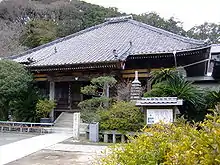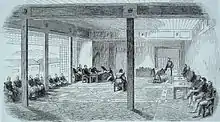
Treaties of Amity and Commerce between Japan and the United States, Russia, France, the United Kingdom and the Netherlands, 1858.

The Ryōsen-ji Temple in Shimoda, where the US-Japan Treaty of Amity and Commerce, the first of the Ansei Treaties, was signed in July 1858.

Signature of the Franco-Japanese treaty in October 1858 in Edo, the last of the Ansei Treaties to be signed.
The Ansei Treaties (Japanese:安政条約) or the Ansei Five-Power Treaties (Japanese:安政五カ国条約) are a series of treaties signed in 1858, during the Japanese Ansei era, between Japan on the one side, and the United States, Great Britain, Russia, Netherlands and France on the other.[1] The first treaty, also called the Harris Treaty, was signed by the United States in July 1858, with France, Russia, Britain and the Netherlands quickly followed within the year: Japan applied to the other nations the conditions granted to the United States under the "most favoured nation" provision.
Content
The most important points of these "unequal treaties" are:
- Exchange of diplomatic agents.
- Edo, Kobe, Nagasaki, Niigata, and Yokohama’s opening to foreign trade as ports.
- Ability of foreign citizens to live and trade at will in those ports (only the opium trade was prohibited).
- A system of extraterritoriality that provided for the subjugation of foreign residents to the laws of their own consular courts instead of the Japanese legal system.
- Fixed low import-export duties, subject to international control, thus preventing the Japanese government from asserting control over foreign trade and protection of national industries (the rate would go as low as 5% in the 1860s.)
Components
The five treaties known collectively as the Ansei Treaties were:
- The Treaty of Amity and Commerce between the United States and Japan (Harris Treaty) on July 29, 1858.
- The Treaty of Amity and Commerce between the Netherlands and Japan on August 18, 1858.
- The Treaty of Amity and Commerce between Russia and Japan on August 19, 1858.
- The Anglo-Japanese Treaty of Amity and Commerce on August 26, 1858.
- The Treaty of Amity and Commerce between France and Japan on October 9, 1858.
See also
Notes
- ↑ Auslin, p.1
References
- Auslin, Michael R. (2004). Negotiating with Imperialism: The Unequal Treaties and the Culture of Japanese Diplomacy. Cambridge: Harvard University Press. ISBN 978-0-674-01521-0; OCLC 56493769
Further reading
- Omoto Keiko, Marcouin Francis (1990) Quand le Japon s'ouvrit au monde (French) Gallimard, Paris, ISBN 2-07-076084-7
- Polak, Christian. (2001). Soie et lumières: L'âge d'or des échanges franco-japonais (des origines aux années 1950). Tokyo: Chambre de Commerce et d'Industrie Française du Japon, Hachette Fujin Gahōsha (アシェット婦人画報社).
- __________. (2002). 絹と光: 知られざる日仏交流100年の歴史 (江戶時代-1950年代) Kinu to hikariō: shirarezaru Nichi-Futsu kōryū 100-nen no rekishi (Edo jidai-1950-nendai). Tokyo: Ashetto Fujin Gahōsha, 2002. ISBN 978-4-573-06210-8; OCLC 50875162
See also
This article is issued from Wikipedia. The text is licensed under Creative Commons - Attribution - Sharealike. Additional terms may apply for the media files.